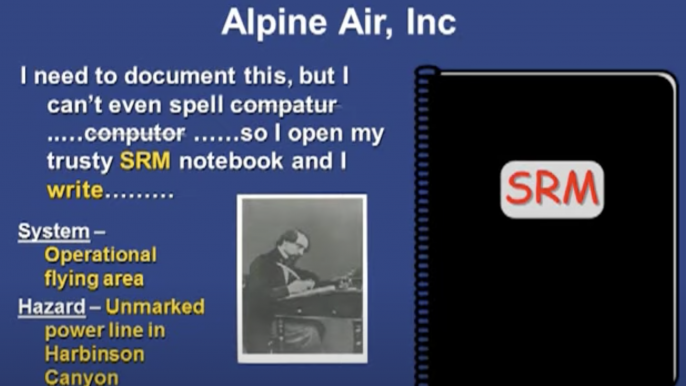
The FAA has been making the case that SMS is scalable since 2013 or before. Scalable means the principles of safety risk management, safety assurance, safety policy and safety promotion can be applied to even the smallest air operator. In an early June presentation to the Flight Safety Foundation’s Business Aviation Safety Summit (BASS), Tiffany LaTour, an assistant manager of the U.S. Federal Aviation Administration’s SMS Program Office, said. “You don’t have to have a complex system. You can have a notebook. If you’re a one-person operation, you need a safety mindset. You can have four pages in a little binder. That’s it.”
The FAA’s Don Arendt, the agency’s original SMS guru, produced a Powerpoint presentation entitled “SMS for Small Operators” in 2013 to emphasize the point. That presentation has since been uploaded to Youtube and you can watch it by searching the internet for that title.
 This single presentation has been referred to multiple times by NTSB experts and officials as the argument for scalability, and is, I think, one of the main supports for the NTSB’s recommendation that all Part 135 operators have an SMS program. The presentation shows how a hypothetical small operator, “Alpine Air,” with two helicopters and four pilots, could have an effective working SMS program. A key element of Alpine Air’s program is a spiral notebook labelled “SRM.” Seated alongside the notebook is a Dickensian figure with a quill pen diligently recording something.
This single presentation has been referred to multiple times by NTSB experts and officials as the argument for scalability, and is, I think, one of the main supports for the NTSB’s recommendation that all Part 135 operators have an SMS program. The presentation shows how a hypothetical small operator, “Alpine Air,” with two helicopters and four pilots, could have an effective working SMS program. A key element of Alpine Air’s program is a spiral notebook labelled “SRM.” Seated alongside the notebook is a Dickensian figure with a quill pen diligently recording something.
The presentation walks through a hypothetical hazard, a new power transmission line near a commonly used flight path, and shows the process of reporting it, recording it in the notebook, analyzing it and assessing it. It shows the severity and likelihood of the hazard plotted on a colorful risk matrix. It explains some possible controls, like mission, weather and night restrictions, and posting notices and warnings. It talks about talking to employees, brain storming and following up.
You’re not done. Now there’s a safety assurance notebook, where you document data acquisition, continuous monitoring, audits, evaluations, investigations and employee reports. You look for negative trends and dangerous conditions, and you assess how well the program is working. There’s safety policy, such a policy letter in your general operations manual, and safety promotion, which is part of your training and internal communications.
It all sounds pretty benign. Can it be this easy, or are there questions that still remain to be answered before all operators begin to buy in? Most people who run flight operations are pilots, and pilots like to fly, are action oriented, and are not particularly intellectual. They are not PhDs, like Don Arendt. They have a highly evolved skepticism based on many years of surviving all the hazards of flight. They have a “show me how this works” attitude and are not persuaded by nice abstractions. They are not inclined to sit at a desk laboriously recording hundreds of data points when they can be flying or running the operation. They know they are going to have to automate some of this, and they want to know what it will cost.
I think it’s time to decide what constitutes a small operator. If you have five airplanes and they are two Navajos and three Cherokees you are small. If you have five airplanes and they are four Gulfstreams and a helicopter, you’re not small. It’s time to spell out more clearly who should adopt what elements of SMS.
It’s time for the FAA to come up with some real-world success stories that either confirm or deny the notebook idea. It’s time to come up with some workable flight data monitoring devices and software that are within the budgets of small operators. It’s time to talk openly about costs and benefits.
Most of the airline safety people who are willing to talk about SMS say it is beneficial, and I believe them. However, I wonder if, in effect, you can take the Queen Mary and shrink it to the size of a rowboat, and still have it work as well as the original? Even if you can do it, can you afford it? I think it’s time we found out.
Editor's Note: The BCA safety column called The Crosscheck by Roger Cox explores the interaction between regulators/investigators and pilots/operators. Send comments to [email protected].





